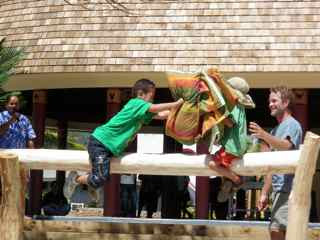Tuesday, September 28, 2010
Traditional boat
 These boats were built and given as gifts to a few countries such as Samoa and Tonga. They are a traditional design and the project aims to educate youth on their history and culture. The early navigators originated here, long before the Europeans arrived. Modern science is now tracing the movement of people through time to flesh out the stories of now dying oral tales.
These boats were built and given as gifts to a few countries such as Samoa and Tonga. They are a traditional design and the project aims to educate youth on their history and culture. The early navigators originated here, long before the Europeans arrived. Modern science is now tracing the movement of people through time to flesh out the stories of now dying oral tales.
Virgin's grave

 The story of the grave is that the young woman buried here was the daughter of the village chief. She was so pure that the lava parted around her grave and flowed around it. Although a fun story, Warren then proceeds to walk around showing us all the other sunken areas that appear not to have lava in this unstable region. We are warned not to stand too close to the grave’s edge lest the lava crumbles and we get to join her.
The story of the grave is that the young woman buried here was the daughter of the village chief. She was so pure that the lava parted around her grave and flowed around it. Although a fun story, Warren then proceeds to walk around showing us all the other sunken areas that appear not to have lava in this unstable region. We are warned not to stand too close to the grave’s edge lest the lava crumbles and we get to join her.
Lava field 2
 This picture tells a few things. The first, which angers and frustrates Warren, is that the upheaval was caused by people taking the lava rock to build decorative walls and ruining the historical significance of the field. Two of the upturned pieces show where the top layer, which cooled very quickly, was remelted by the hot lava below. The rusty coloured line is oxidation. Although hard to see here, the May and February flows are slightly different colours: one brown and one black. Warren had samples taken and their compositions were identical. German studies solved the mystery: one was rained on before cooling and the other was left dry.
This picture tells a few things. The first, which angers and frustrates Warren, is that the upheaval was caused by people taking the lava rock to build decorative walls and ruining the historical significance of the field. Two of the upturned pieces show where the top layer, which cooled very quickly, was remelted by the hot lava below. The rusty coloured line is oxidation. Although hard to see here, the May and February flows are slightly different colours: one brown and one black. Warren had samples taken and their compositions were identical. German studies solved the mystery: one was rained on before cooling and the other was left dry.
Traditional Fun and Games





Cory asked the announcer if he could play too. Then we heard the announcement that Cory had come all the way from Canada to try out Samoan games. Would anyone join him? Sean volunteered and the crowd was in hysterics as they pushed each other off and occasionally fell off all on their own. Mya wanted on too!
Traditional tatooing


 The missionaries tried to ban it, but this part of tradition remains somewhat intact. We are told there are 3 tufuga, tattoo artists, in Samoa: father, son and grandson. This process takes hours and hours. This is a demonstration at the festival and we watched the son take over from his father. The other men hold the skin tight to keep the shape of the patterns being created to tell a story. It is said that men receive the tattoo as a right of passage and as well as the unique story it tells, it represents the pain that women must bear in child birth. Fair is fair right?
The missionaries tried to ban it, but this part of tradition remains somewhat intact. We are told there are 3 tufuga, tattoo artists, in Samoa: father, son and grandson. This process takes hours and hours. This is a demonstration at the festival and we watched the son take over from his father. The other men hold the skin tight to keep the shape of the patterns being created to tell a story. It is said that men receive the tattoo as a right of passage and as well as the unique story it tells, it represents the pain that women must bear in child birth. Fair is fair right?A full pe’a covers from waist to knees and takes 48 hours, not likely all in one go.








































